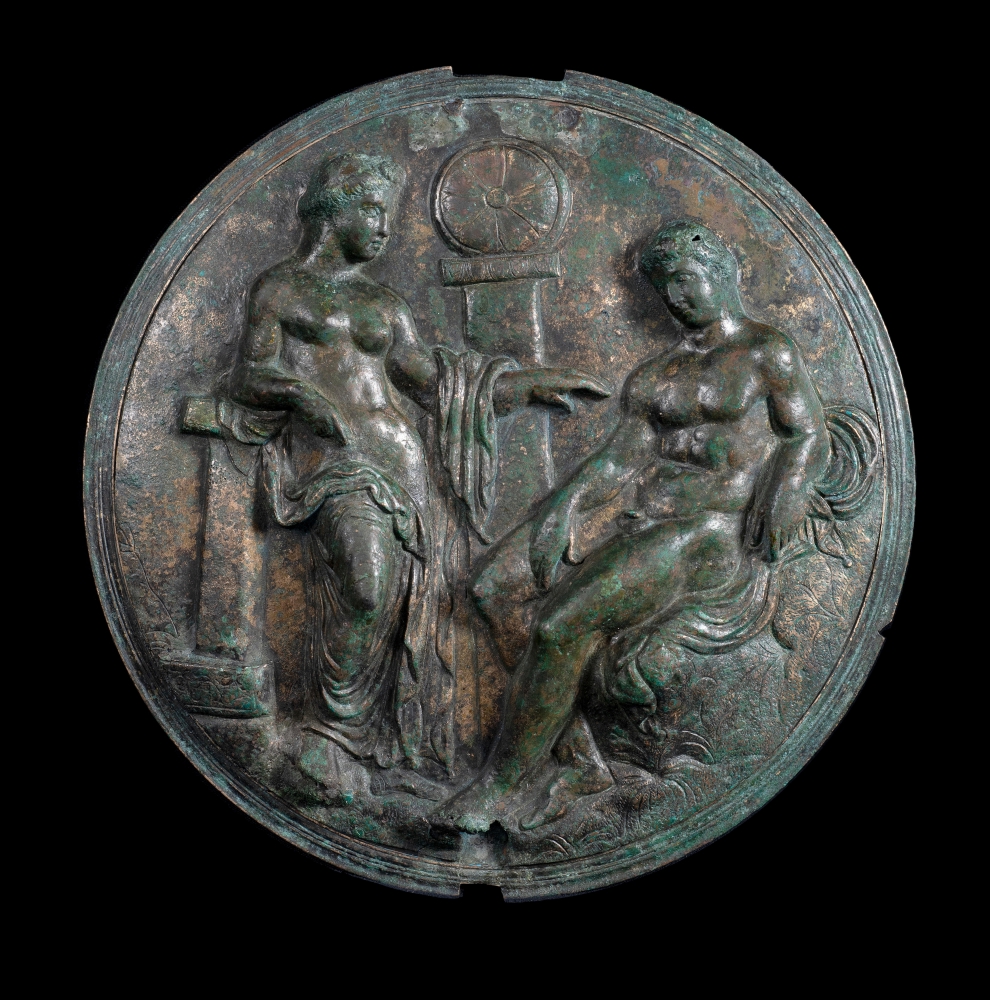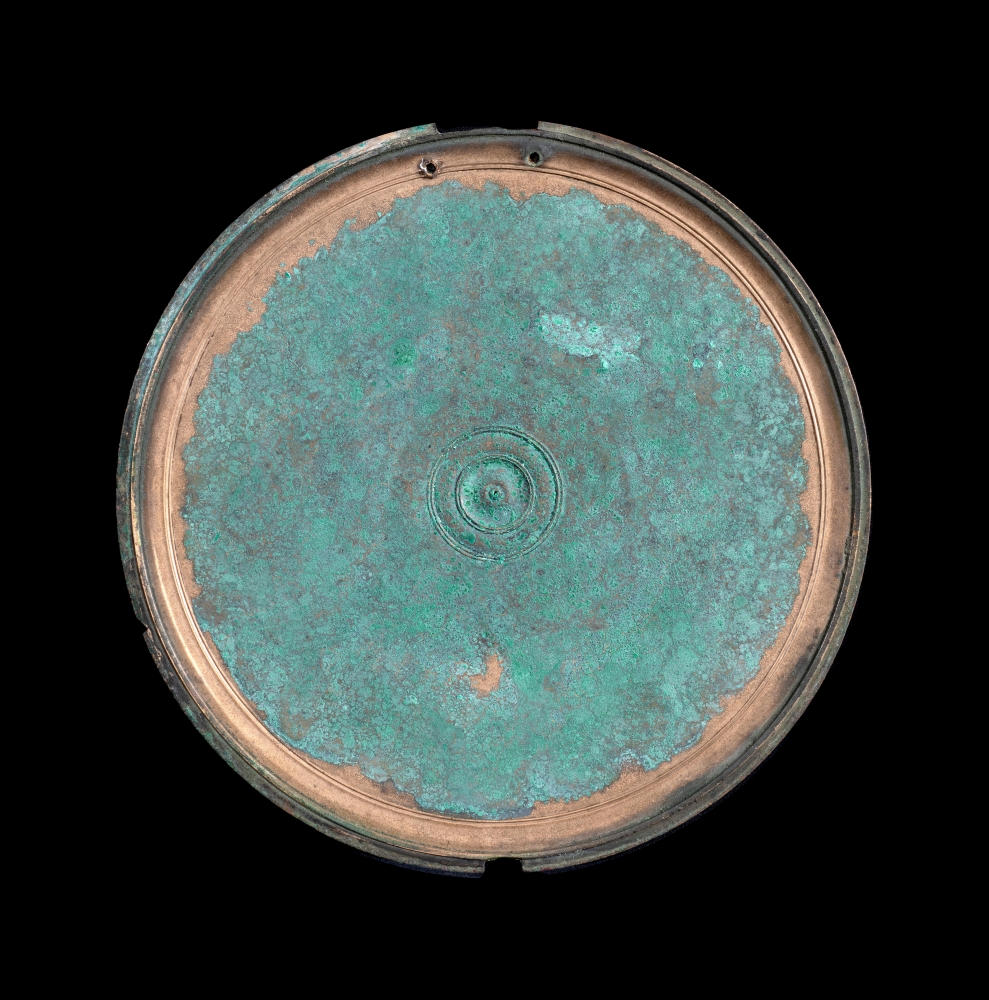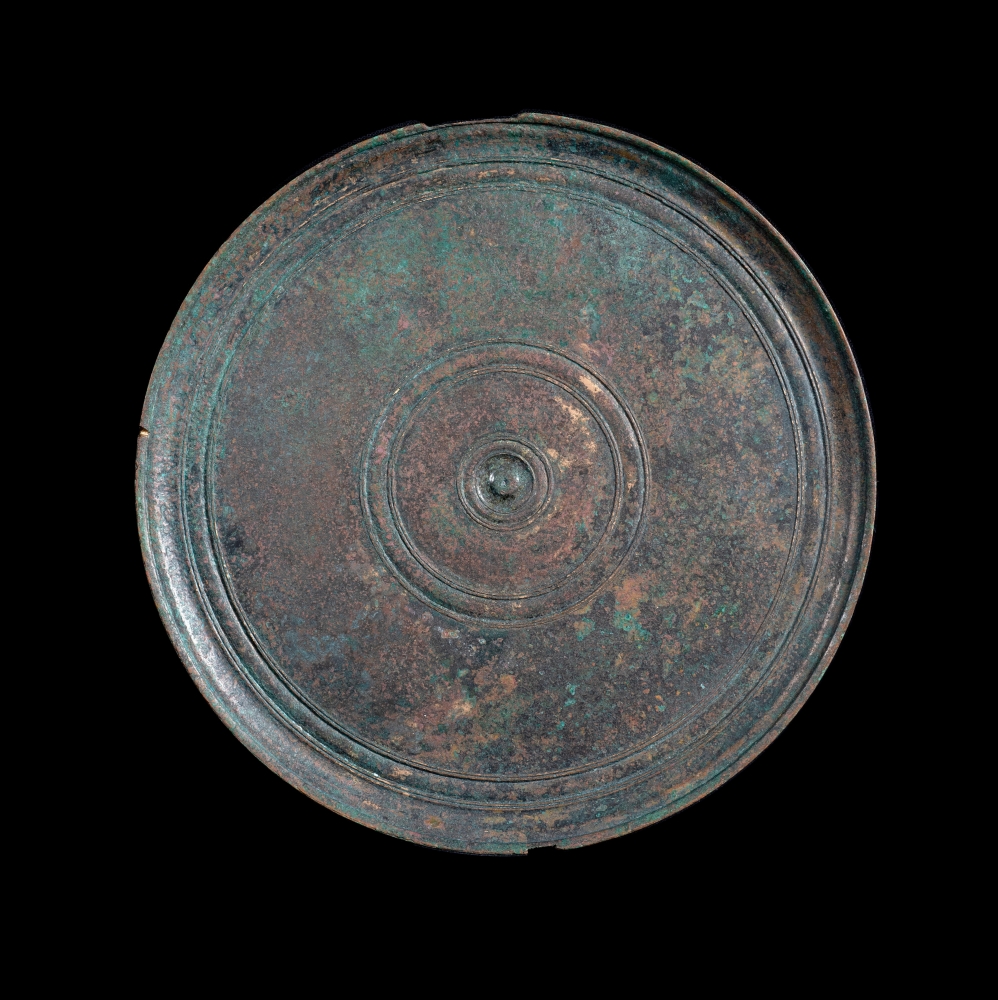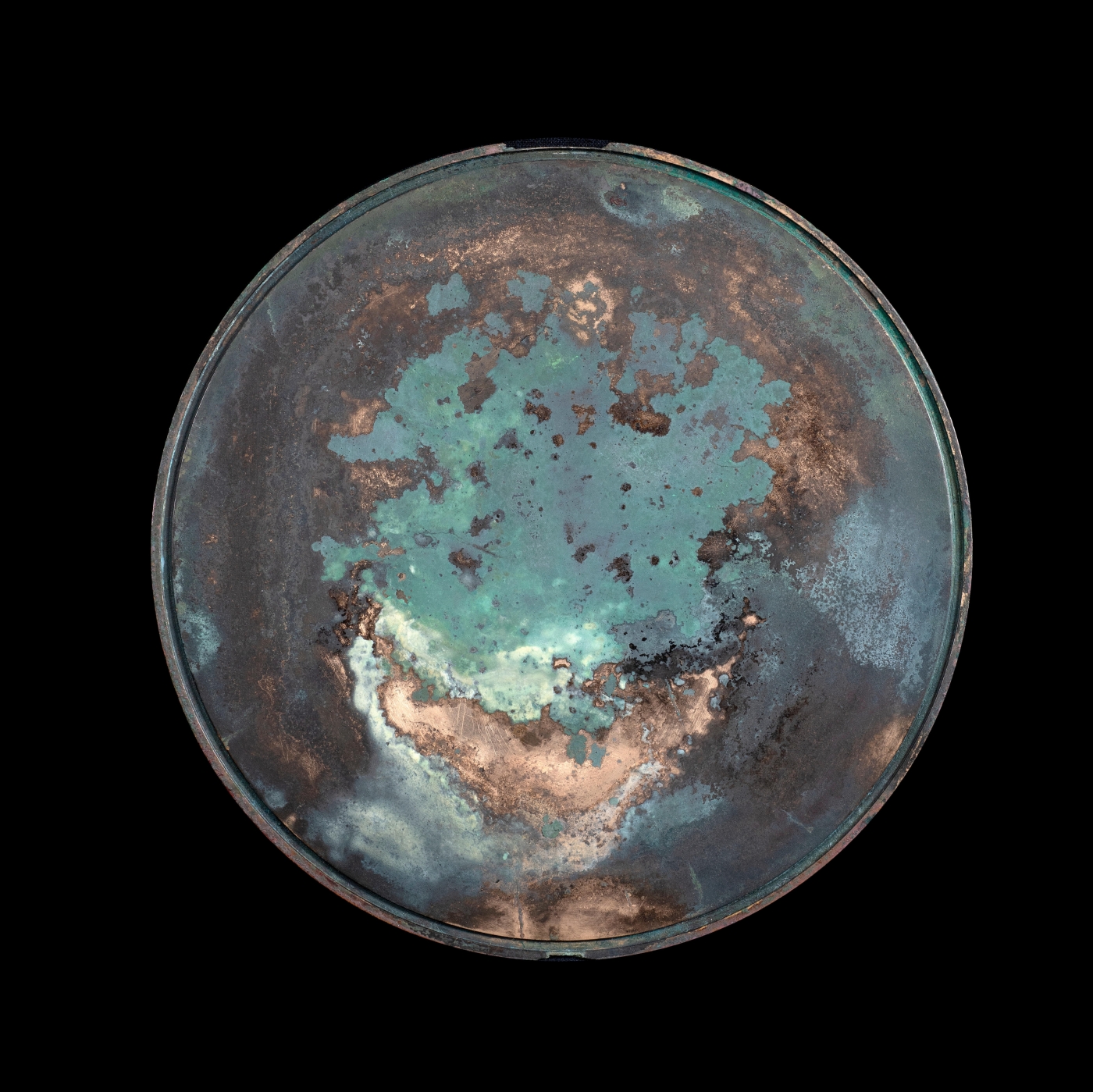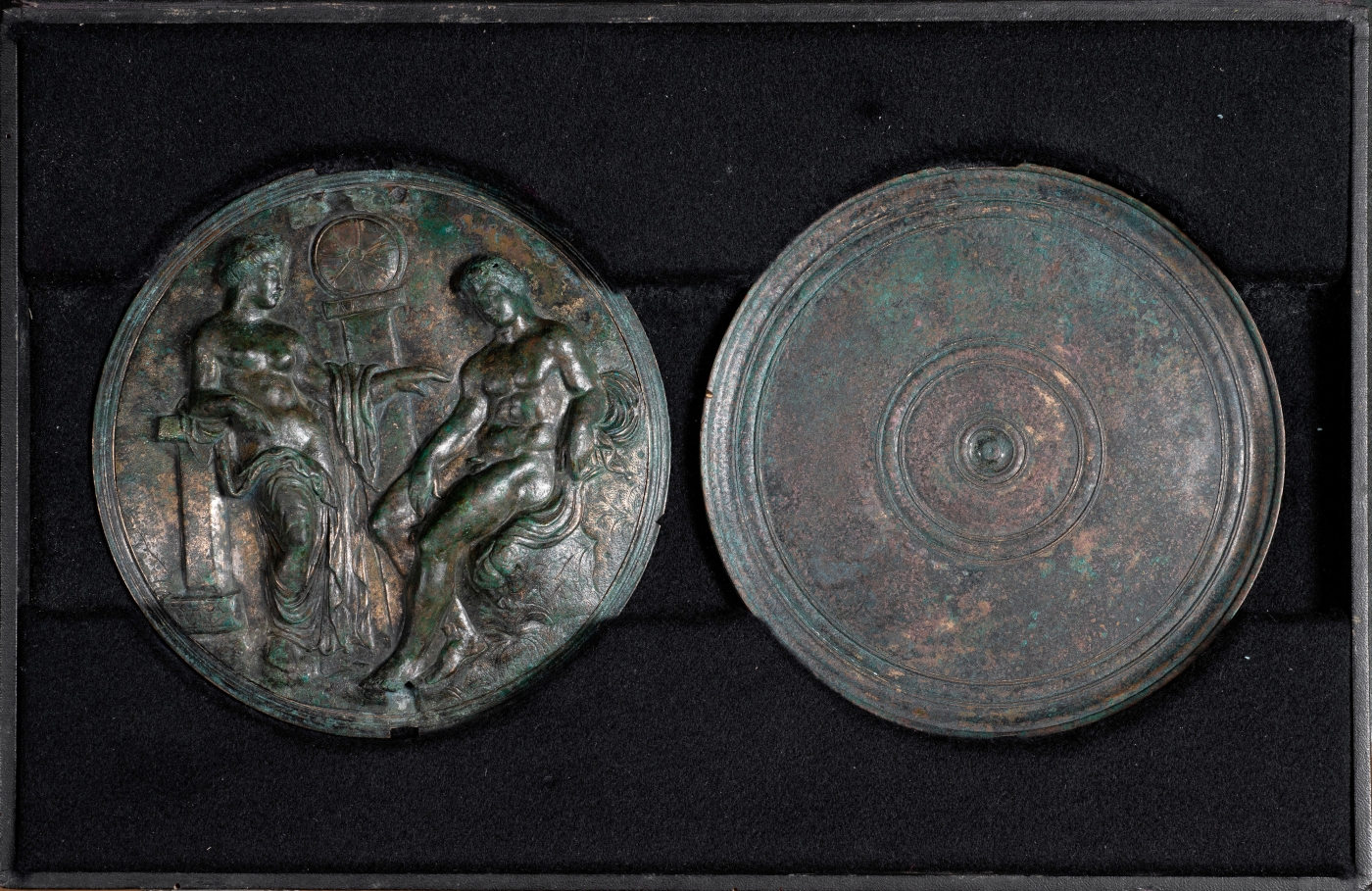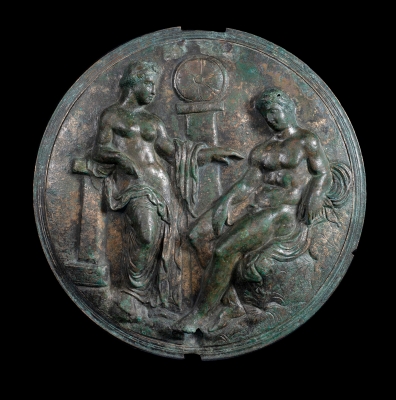Collection of Eleni Princess Cantacuzino (d. 1909), sent to London from Moscow in 1906 as a gift to her daughter Marie Princess Cantacuzino-Theophilou;By descent, Collection of Athanase (d. 1963) and Maria (née Economopoulos) Sarmas;
By descent, Collection of Theodore Sarmas, London 1963-2003;
Sold to a European Private Collection, 2003;
Private Collection (Berlin) 2003-2023.
Click here to download the factsheet
The present artwork is a box mirror, an example of the extremely high quality of Hellenistic metalwork. Like a modern compact mirror, the two pieces of this mirror were originally hinged together. The disc featuring the repoussé decoration on its exterior is incised on its interior in the same manner as the exterior of the other disc, and served as a cover for the unadorned, highly polished piece of bronze that was the mirror itself. A small latch was originally attached at the bottom of the relief scene so that the cover could be lifted, and the mirror revealed: the hole at the left foot of the male figure indicates where the latch was placed. On the edge opposite this ring, a suspension hook was originally connected to the hinge mechanism, allowing for the mirror to be hung on a nail when not in use and the relief to become wall decoration. In this way, the relief scene can be considered a sculptural tondo, and the mirror as such is as much a decorative object as a functional one.
The relief scene, framed by concentric incised bands, shows a pair of figures. On the left, a partially nude female leans on a low column. She stands on the rocky ground, her left leg visible in profile while her right, viewed frontally, extends into three-dimensional space towards the viewer. Her garment, rendered with exceptional skill, enswathes both legs, and is held atop the column by her right arm, while another portion is slung over her left arm. She extends her left arm towards the male figure on the right of the composition, with the palm of her hand turned towards the ground. The male figure is seated on a boulder, fully nude, leaning back on a cloth draped over the boulder. His legs, crossed, extend to the bottom of the composition, and he appears to be in a state of repose. The foreground features incised renderings of flora: small bushes are visible in front of the boulder and beyond the column. In the upper portion of the composition, a tall column looms over both figures, and a shield with an incised rosette rests atop it, miraculously standing on its edge so that a viewer can understand its shape.
Though there are no known parallels to this exact relief scene, much can be deduced about its subject matter through comparisons to other known artworks from the period.
The female figure on the right can be identified as Aphrodite with a good deal of certainty. Her pose and drapery are most immediately reminiscent of the Venus de Milo. Though scholarly opinion has in recent years has placed the creation of this sculptural type in the second century B.C., it is not unlikely that variations of a similar composition existed well before, especially in media made on a smaller scale such as that of the present mirror. Praxiteles is credited with the first nude sculpture of Aphrodite when he was commissioned in the fourth century B.C by the city of Knidos to make a cult statue of the goddess for their temple. Greek artists had depicted males in the nude for over three hundred years, the so-called “heroic nude” of gods and their mythical children, but the naked Aphrodite represented an unparalleled cultural innovation in the representation of women. Her nude image is supposed to have evoked male responses of sexuality, thereby evincing her power as the goddess of love.
The identity of the male opposite Aphrodite is less clear. The best clue that the composition provides is the inclusion of the shield between the two figures, signaling that the man is in some way associated with the battlefield. Among divine figures, the most likely god is Ares, the god of war and lover of Aphrodite. Though he is typically depicted in statuary holding a sword or spear (see for example the Ludovisi Ares), in this case the company of Aphrodite may have made a weapon inappropriate. Another strong supposition is Achilles, the famed hero who fought and died in the Trojan War: unlike other heroes from the Homeric epics, he is not depicted bearded, as he was a young man even at the time of his death. Certain other characters from Greek mythology can be excluded from consideration on the basis of iconography. Though Aphrodite is known to have had special relationships with both Paris and her son Aeneas, comparison with other bronze reliefs from the period shows that these Trojan warriors were depicted as non-Greek: they wore Phrygian caps and other markers of ethnic difference.
Box mirrors began to be produced during the second half of the fifth century B.C., gaining more widespread popularity in the following century. Many of these mirrors have been attributed to the city of Corinth, a famous center of Greek luxury goods located on the isthmus bearing its name that connects the Peloponnese to mainland Greece. Scholars have posited that these mirrors display the merging of the renowned tradition of Corinthian metalwork with compositions and style borrowed from workshops producing wall paintings in the neighboring city of Sicyon. It is more probable, however, that there existed other centers of manufacture throughout the Greek world.
References:
David G. Mitten and Suzannah F. Doeringer, Master Bronzes from the Classical World (Boston, Fogg Art Museum Exh. Cat 1967) p. 114-115, nos. 111-112.
Mary Cornstock and Cornelius Vermeule, Greek, Etruscan and Roman Bronzes in the Museum of Fine Arts Boston(Meriden, Connecticut 1971).
Claude Rolley, Greek Bronzes (London, Sotheby’s Publications 1986). See p. 176 fig. 156 and p.245 no.283 for two mirrors in the Athens National Museum
Agnes Schwarzmaier, Grieschische Klappspiegel. Untersuchungen zu Typologie und Stil (Berlin 1997). This is the most comprehensive study of box mirrors with a catalogue of 297 examples, many of them illustrated in 90 plates.
